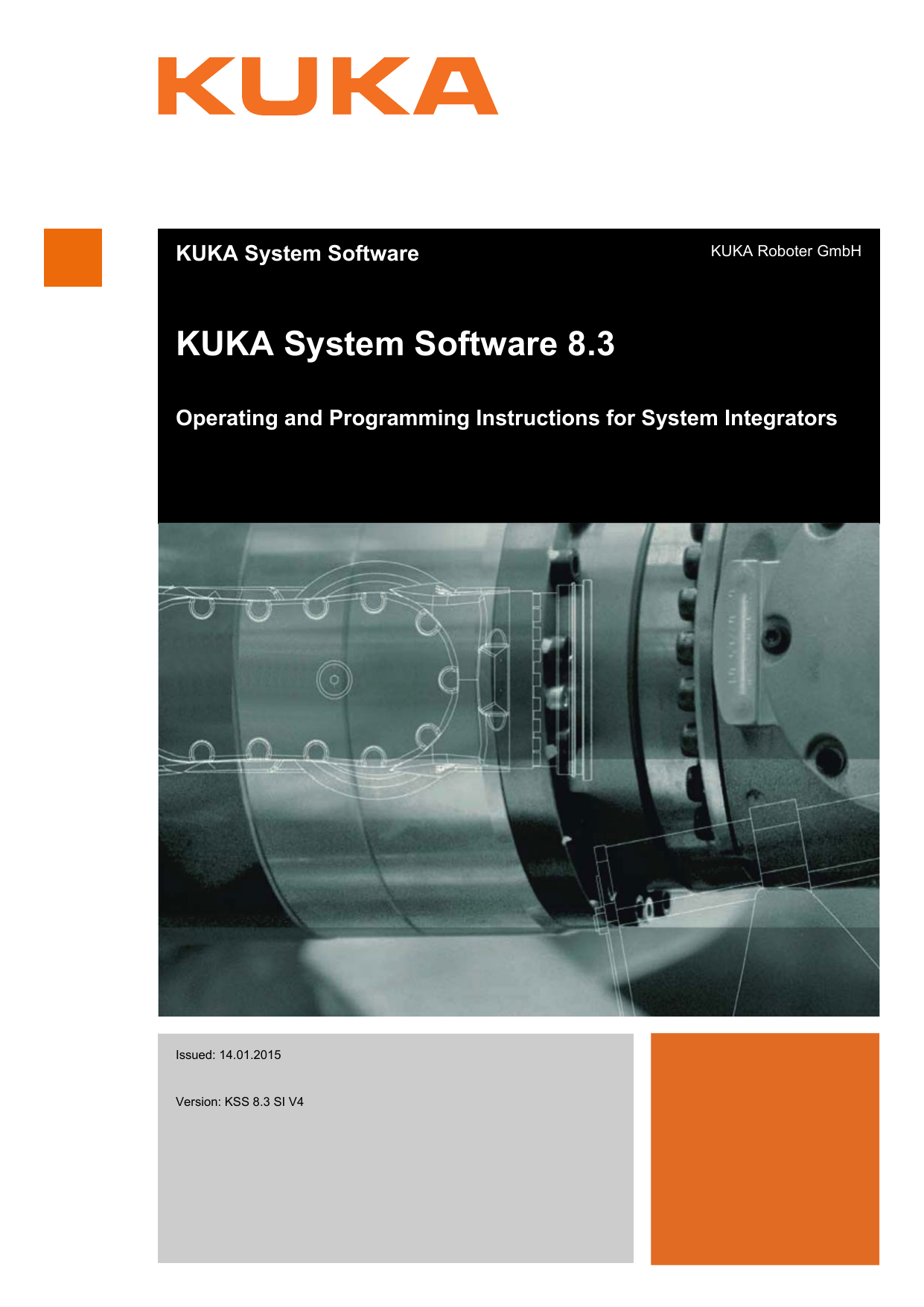Cartesian trajectories for the KUKA robots (KRC/KRL).

Refer to Expert Programming Manual. Title: KUKA User Manual Author: Trumen Created Date: 2:19:34 PM. 11: The KUKA Robot Programming Language TOPIC 1: Movement The KUKA robot can move from point A to point B in three main ways. PTP – Point-to-Point – Motion along the quickest path to an end point. This motion requires the programmer to “teach” one point. LIN - Linear – Motion at a defined velocity and acceleration along a. I need kuka krc1 programming manual hello i need kuka krc1 programming manual thank you. Advanced Search. You can Sign Up for free! Course - Robot programming KUKA Advanced Description: The aim of the PRO course is to update the upskilling of knowledge in handling the robot cell, to modify the program, to work in the programming language KRL, to understand the extended instructions and critical programming elements and for the picking intended for the management. The intuitive KUKA smartPAD can be used to create complex and customized programs for robot motion steps and tasks in a broad range of applications – both online and offline. Incredibly efficient: programming with inline forms The KR C4 controller provides inline forms for the fast, error-free programming of tasks and motion steps.

| Teach pendant | “KCP” (KUKA Control Panel) or smartPAD |
| Programming / simulation software | OrangeEdit editor / KUKA simulator Sim Pro |
| Software | KUKA System Software (KSS) |
| User interface | KUKA smartHMI (smart Human-Machine Interface) |
| Programming language | KRL (KUKA Robot Language) |
| Relevant hardware | KR C2 / KR C3 / KR C4 and probably others |
- Further reading
Trajectory composition¶
Cartesian trajectories can be composed in three ways (see manual_slides p. 23-32).:
- Linear Cartesian motions
LIN
- Circular motions
CIRC
- Joint space interpolation
PTP
joint space movement to a given goal, which can be specified in joint space or in Cartesian space.
controller calculates the necessary angle differences for each axis
Preferred motion if a high TCP speed is wanted and the interpolation between both waypoints doesn’t have to follow a predefined path.
- Additional
SLIN
- The Spline Linear motion uses splines between linear motions
SCIRC
- The Spline Circular motion uses splines between circular motions
SPTP
- The Spline Point to Point motion is similar to PTP but it allows continuous spline motions.
Waypoint representation¶
(see kuka_system_software and manual_slides)

- Angles of rotation of the robot coordinate systems
- S and T specify a robot’s position unambiguously if more than one axis position is possible forthe same point in space (because of kinematic singularities). This is often written in integerform, thus the values above.
- S (status): 3-bit binary value describing the robot’s configuration with predefined criteria
- T (turn): direction of a turn.6-bit binary value, containing flip bits for each axis (0 when axis >= 0 deg, 1 when axis < 0deg)
| Angle | rotation axis |
|---|---|
| A | Z |
| B | Y |
| C | X |
Trajectory parameterization and execution¶
(see manual_advanced)
Specification of velocity¶
Speed of TCP can be set within a move instructions in % by the ‘vel’ argument.
For Continuous path motions ([LIN], [CIRC]) the velocity is constant from start to end.
Realtive Joint Velocity can be set by: setJointVelocityRel(0.3)
KUKA operation mode influence velocity
Mode description velocity T1 Manual Reduced Velocity max of 250mm/s T2 Manual High Velocity as programmed AUT Automatic as programmed EXT Automatic external as programmed CPR Safe Operation max of 250mm/s
specification of acceleration¶
Relative Joint Acceleration can be set by: setJointAccelerationRel(0.5)
Blending¶
Kuka Krc2 Controller Manual
(source Angerer and Vistein)
Blending is enabled by the advance run mechanism enabling planning the next motion while executing a motion.
To activate blending a motion needs to be marked as blendable by adding a keyword to the motion instruction. C PTP`for PTP motions and `C_DIS, C_VEL or C_ORI for motions in operation space.
Blending between all motion types is supported. It is even possible to blend a PTP (joint space) into a LIN (Cartesian space) and vice versa.
Blending can be done by defining a blend radius
- as a relative value: IMotion.setBlendingRel(0.2)
- in millimeters: IMotion.setBlendingCart(20)
Parallel IO operations¶
No information found so far
Online (real-time) trajectory modifications¶

Robot Sensor Interface (RSI) (see RobotSensorInterface)
- supported since KRC-4 controller
- influence the position of the robot by external sensors.
- robot position can be influenced by external sensors through overlaying a programmed motion with external control, like position correction from a sensor-based system
- default 4 ms cycle time for accepting set point, hence external controller requires hard real-time
- usually correction data is provided in relative values and applied directly to the running program. However, as absolute values are possible, the robot can be controlled externally while a KRL program only providing a fixed start position runs in the background.
- communication between KUKA and external controller via UDP/IP on a dedicated network segment
- RSI context is a library with RSI objects for configuration of the signal flow
- RSI monitor offers online a visualization of the RSI signals.
Kuka Robot Manuals Pdf
I'm looking for an advanced programming manual for FD11 Controller 9th edition. Does anyone know if there is an advanced programming manual available? I currently only have the basic operations manual.
Thanks
- Navigation
- Home
- Forum
- Members
- Shop
- My Account
- Calendar
- Options
- Current Location
www.robot-forum.com in the WSC-Connect App on Google Playwww.robot-forum.com in the WSC-Connect App on the App StoreThis site uses cookies. By continuing to browse this site, you are agreeing to our use of cookies.Your browser has JavaScript disabled. If you would like to use all features of this site, it is mandatory to enable JavaScript.
